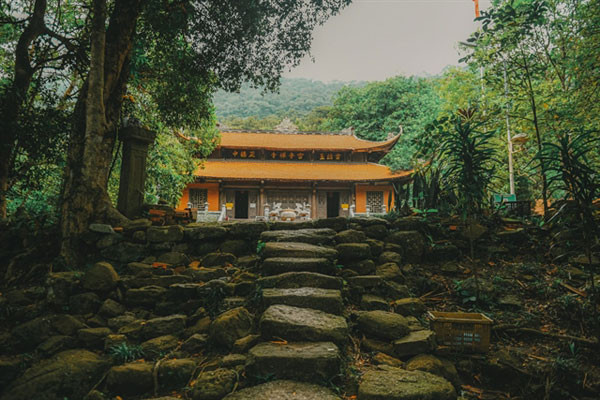
Many tourists visit the northern province of Quang Ninh not only to contemplate the stunning beauty of the world’s natural wonder, Ha Long Bay, but also to find inner peace at tranquil ancient pagodas that are aplenty.
Lesser known and less crowded than Yen Tu or Ba Vang pagodas, Loi Am Pagoda is one of the most sacred spiritual sites in the province.
Built in the 15th century during the reign of Emperor Le Thanh Tong (1442-1497), the 700-year-old pagoda is also one of the oldest in Vietnam.
Loi Am Pagoda is located on a mountain range with an altitude of 503m within Dai Yen Ward in Ha Long City. It is surrounded by a charming landscape, similar to that of a beautiful plateau.
Behind the pagoda are Giai Oan Stream and Tien (Fairy) Well with transparent crystal water, bringing freshness all year round.
Loi Am Pagoda is situated next to Hang (Cave) Pagoda, also known as Lau Cau. It is a natural stone slab with a total area of 8,5sq.m and 2,2m height, protruding like a one-roof house. From a distance, it looks like a giant iguana.

It takes visitors around one hour to climb seven hills and follow a narrow path to reach the site. However, the path might be dangerous for some due to many bends. It can be become slippery on rainy days. The difficulties in accessing might explain for the tranquillity of the pagoda.
Otherwise, visitors can choose the much easier way – taking the cable car, powered by solar energy, which will take them the 3km-distance in just a matter of minutes. However, most pilgrims prefer following to path as they reckon that the more difficulties they have overcome to reach the pagoda, the more devotion they obtain.
Along the path are rows of tall luxuriant ancient trees on both sides, under which are carpets of pineapples stretching for as far as the eye can see. On winter days, the landscape here is engulfed in a sea of white fog, resembling a miniature fairyland.

Loi Am Pagoda is relatively small compared to the overall picture of nature. It is nestled on a large mountain, among the endless stretches of trees and hazy clouds, away from the hustle and bustle of the city life. However, the majesty of the pagoda does not make it overwhelmed by the surrounding nature.
The ancient beauty of the pagoda is the highlight of the poetic and sacred picture there. It was built with a curved roof tile design and pillars carved with extremely sophisticated dragon and phoenix motifs.
The architectural details of the building, from the stairs, the balcony to the door, are all imbued with nostalgic colours. Meanwhile, its ground is laid with terracotta bricks, evoking the familiar scenery of any villages in northern Vietnam.
Interestingly, pilgrims to Loi Am Pagoda bring along red bricks instead of money as their offerings. The reason is that the building has been gradually degraded over time but the transportation of building materials is difficult due to its remote and high location. However, the bricks will have been prepared beforehand by the monks so visitors just need to take them to the donation place. Both tourists and Buddhists have contributed to carrying bricks to the pagoda, which is believed to demonstrate their hearts and devotion.
Besides getting immersed in the ancient sacred space, visitors also have the opportunity to admire the beautiful scenery below from Loi Am Pagoda.

Lying by the foot of the mountain are Yen Lap Lake, one of the largest artificial freshwater lakes in Quang Ninh Province. Emerging from the water are abundance of islets like Canh, Giap Gioi or Ban Tay islets. Tourists could also catch sight of immense pine forest covering towering, poetic hills. The scenery is similar to a miniature of Ha Long Bay.
During autumn afternoons, the sunlight makes the lake surface shimmer, creating a stunning picture of nature.
Many services are being on offered so that visitors could explore the beauty of Yen Lap Lake, like kayaking or sailing.
In 1997, Loi Am Pagoda was recognised as a national historical and religious heritage, and became a famous and sacred tourist attraction in Quang Ninh.
The Loi Am Pagoda Festival is annually held on the 27th day of the first lunar month, attracting thousands of tourists and pilgrims to the pagoda to pray for peace and fortune while enjoying the beautiful nature.
Source: Vietnam News